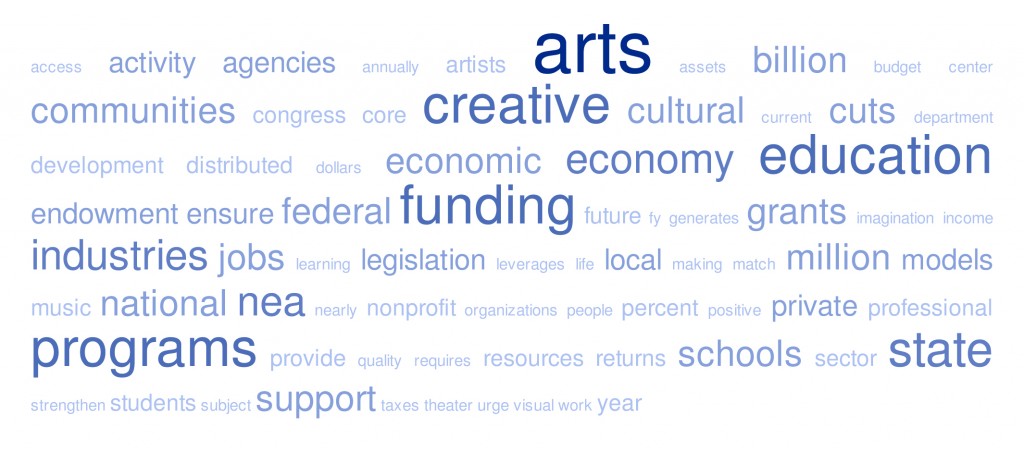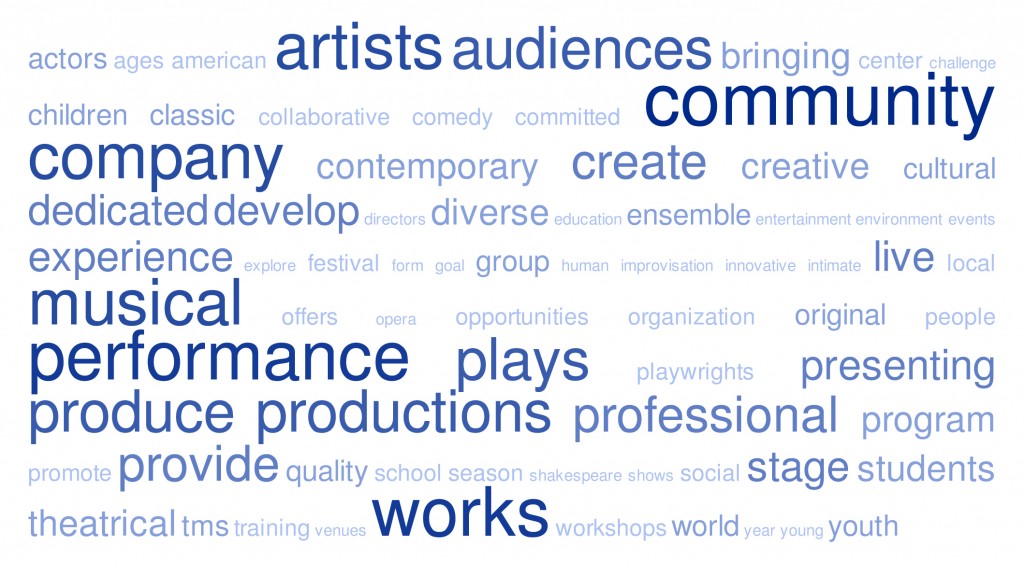These past few weeks three things happened that got me thinking about the linguistic disconnects between us as artsmakers, those who advocate for us, and those who are supposed to be listening to that message. A crazy dance occurred in Washington around the budget and the possible defunding of the NEA (result: a haircut and the threat of a guillotine next fall). Artists and adminstrators from across the country marched on Washington for Arts Advocacy Day. And I frantically worked to build out some content for this new blog, which will discuss the language we use around audience engagement.
For a while now, I’ve noticed a real prevalence in the advocacy language of economic terms—equations showing money-in/money-out benefits to funding the arts, discussions of “good policy,” “profit,” and “affordability.” Here’s a word cloud drawn from some of the advocacy language used just around this latest effort to head off efforts to defund the NEA, drawn from advocacy language from Americans for the Arts and the state and city arts advocacy groups in Philadelphia, California, Minnesota, Virginia, Arizona and West Virginia:
The most prevalent word (after “arts”) is “education,” which makes sense since much of current arts policy thinking revolves around the benefits of arts on schoolchildren in terms of their intellectual and social development. Fair enough. But then look—“programs,” “industries,” “economy,” “million,” “billion.” Interspersed in there are some less economically-driven language like “creative,” “artists,” and “cultural,” but really, perhaps because these arguments were being made for essentially economic gain (i.e. not losing money in the budget), they are essentially economic.
(A caveat here that there are, of course, wonderful examples of people making non-economic arguments for the value of the arts, including at AFTA and elsewhere. Check out, for example, this very recent (very awesome) blog post from Randy Cohen at AFTA. In general, however, it is my understanding that those arguments aren’t usually the ones carried forward to legislators, often because they’re based in feelings rather than numbers.)
(A further caveat that we clearly now need economic and numbers-based arguments for the value of the arts. This blog in general isn’t about replacing any valid argument for the value of the arts, it’s about augmenting those arguments with new ones.)
So, keep that one in your head. “Programs,” “industries, “million,” “billion.” Now take a look at another special interest group’s messaging about the arts…the Republicans. Here is a word cloud generated from as many speeches and blurbs as I could find about the NEA from Republican naysayers from Sarah Palin to John Boehner to Rush Limbaugh to John Kyl:
Surely not surprising, but it turns out the NEA, and arts in general, are being used as a front for attacking Obama and his other policies. The word “things” (as in, in Sarah Palin’s words, “frivolous things”) comes up more frequently than the thing itself, “arts,” (as does that favorite effigy of the far right, Obama) and grandstanding words like “passion,” “people,” “speech,” and “agenda” float high in the mix. (Ironically, “passion” is perhaps the closest thing to one of the core impacts of the arts that anyone is connecting to it right now. Too bad it’s generally a passion to cut government funding to zero.)
So there are essentially the two sides – our advocates versus our critics, duking it out for our relatively paltry $160 million slice of the pie. The kicker, though, is that neither of these word clouds reflects how we talk about ourselves in our purest form—which is to say, in the missions of our organizations. Here’s one last word cloud showing high-frequency words from the mission statements of about 300 theatre companies of all sizes in the San Francisco Bay Area:
Top words: “community,” “performance,” “experience,” “create,” “artists.” We value ourselves as conduits for and to communities. We create works, performances, artists that are of value to Big Important Groups like the “world” and our “youth.”
It’s perhaps an obvious point that we don’t spend a lot of time talking about how we generate millions or billions of dollars in our communities. Perhaps less obvious is that we don’t spend a lot of time talking about tangibles at all. We “challenge.” We create “intimate” experiences. We make people better “humans.”
The point of this whole blog is try to understand how we can spend the equivalent of two NEA budgets every day on war, and then turn around and cut $14 million out of that NEA budget for “fiscal responsibility.” How have we become embroiled in economics? Why are we a political punching bag? Why is art something that Sarah Palin calls frivolous? What can we do about it?
Cloud image: “Desert Clouds” by Eileen Braybrook from Flickr, used under Creative Commons license.



